Motorbike finance offers a range of options for purchasing a bike without the need to pay the full amount upfront. Whether you’re looking for a new motorbike or a used one, motorbike finance can provide the flexibility you need to get on the road. By understanding the different finance options available, you can make an informed decision and find the best deal for your budget and requirements.
There are various finance options available when it comes to motorbikes. These include credit cards, bank loans, hire purchase (HP), and personal contract purchase (PCP). Each option has its own advantages and considerations, so it’s crucial to understand how motorbike finance works before making a decision.
Key Takeaways:
- Motorbike finance offers flexible options for purchasing a bike without the need for a significant upfront payment.
- There are different types of finance available, including credit cards, bank loans, hire purchase (HP), and personal contract purchase (PCP).
- Each finance option has its own advantages and considerations, so it’s important to understand how they work before making a decision.
- Consider factors such as interest rates, ownership, monthly payments, and end-of-agreement choices when choosing motorbike finance.
- Applying for motorbike finance involves completing a finance application and providing accurate information about your credit history and financial situation.
Cash or Credit: Which is Best for Buying a Motorbike?
If you have the cash available, buying a motorbike outright can be the most cost-effective option. It allows for more negotiation power with sellers and avoids the need to secure finance. However, carrying large amounts of cash can be risky. If you don’t have cash on hand, you can explore credit options such as using existing credit cards or getting a bank loan.
Many dealers also offer their own finance packages, including hire purchase and personal contract purchase plans. These finance providers are experienced in the motorbike industry and can provide tailored motorbike loans to suit your needs.
Using a credit card for motorbike finance can be a convenient option if you already have a card with an available credit limit. However, it’s important to consider the interest rate associated with credit card finance, as it is often higher than that of bank loans. This could result in higher overall costs. Paying attention to interest-free periods and balance transfer options can help you save on additional interest charges. Online finance calculators can assist in determining monthly payments and evaluating total costs.
Using a credit card for motorbike finance can be simple and convenient if you already have a card with an available credit limit.
If you prefer to explore bank loan options for motorbike finance, you can easily apply online and have funds available quickly. Bank loans generally offer lower interest rates compared to credit cards, making them a more affordable choice. However, keep in mind that bank loans are subject to credit checks, and a good credit score may be required for approval.
Comparing Cash and Credit Options for Motorbike Finance
Here’s a comparison of cash and credit options for buying a motorbike:
| Option | Advantages | Considerations |
|---|---|---|
| Cash |
|
|
| Credit |
|
|
Ultimately, the choice between cash and credit for buying a motorbike depends on your personal circumstances and preferences. It’s important to consider factors such as your financial stability, risk tolerance, and the overall cost involved in each option.
Also Read : Get Fast Loans With The Money Platform
Understanding Credit Card Finance for Motorbikes
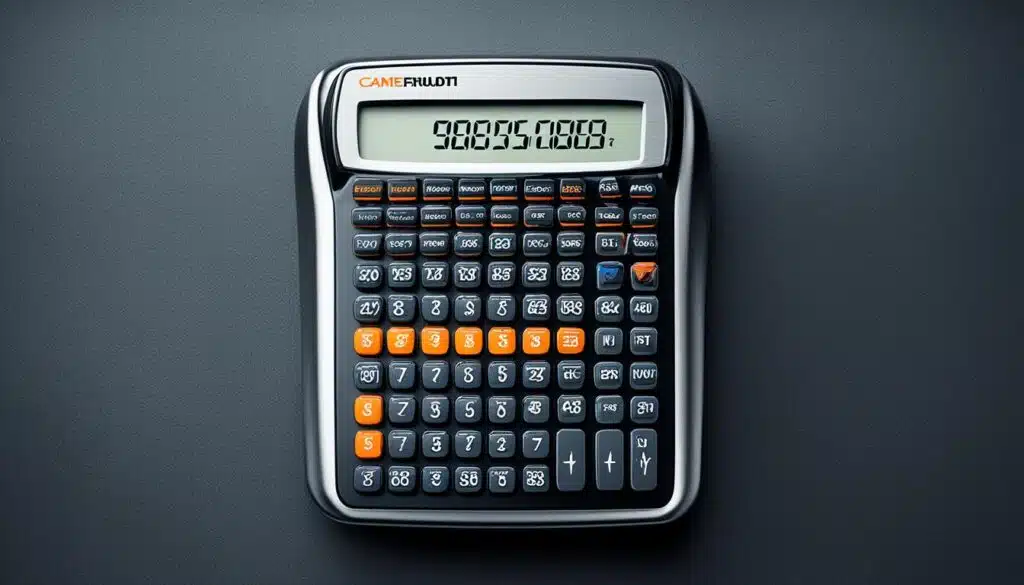
When it comes to financing a motorbike purchase, credit cards can offer a simple and convenient solution, especially if you already have a card with an available credit limit. However, it’s important to understand the ins and outs of credit card finance to make an informed decision.
One key consideration is the interest rate. Interest rates on credit card finance for motorbikes are often higher compared to bank loans. This means that if you choose to finance your motorbike using a credit card, you may end up paying more in overall costs due to the higher interest charges.
Another factor to bear in mind is the presence of interest-free periods and balance transfer options. Many credit card providers offer interest-free periods, during which you won’t be charged any interest on your motorbike finance. This can be advantageous, especially if you can pay off the balance within the interest-free period. Additionally, some credit card providers allow you to transfer your existing balance from another card to take advantage of lower interest rates or promotional offers.
To gain a clearer understanding of your monthly payments and total costs, consider using an online finance calculator. These calculators take into account your credit card’s interest rate, the amount financed, and the repayment period to provide you with accurate figures. This can help you budget effectively and make an informed decision about your motorbike finance options.
Using a credit card for motorbike finance can offer convenience, but it’s crucial to consider the higher interest rates and explore the benefits of interest-free periods and balance transfer options. Utilizing an online finance calculator can provide a clear picture of your monthly payments and help you make an informed decision.
To illustrate the potential savings and costs associated with credit card finance for motorbikes, let’s take a look at the following example:
| Credit Card Option | Interest Rate |
|---|---|
| Card A | 17% |
| Card B | 20% |
| Card C | 22% |
In this example, Card A offers the lowest interest rate at 17%, while Card C has the highest at 22%. By comparing the interest rates of different credit cards, you can identify which card offers the most favorable terms for your motorbike finance. It’s essential to consider the interest rate carefully, as even a small percentage difference can significantly impact the overall cost of your motorbike purchase.
By understanding credit card finance for motorbikes and considering the interest rates, balance transfer options, and online finance calculators, you can make an informed decision that aligns with your financial goals and budget. Keep these factors in mind when exploring your motorbike finance options to ensure you choose the best solution for your needs.
Also Read : Essential Tips For Accurate Stock Market Analysis
Exploring Bank Loan Options for Motorbike Finance
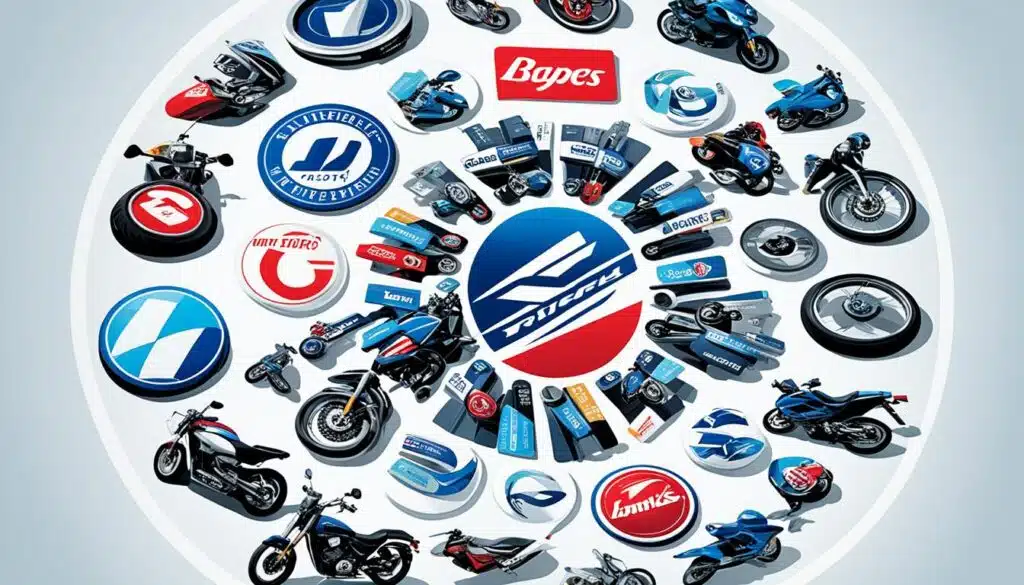
When it comes to financing a motorbike, bank loans are a popular option for many riders. They offer several advantages, including lower interest payments, flexibility, and a clear repayment plan.
One of the key benefits of bank loans for motorbike finance is the lower interest rates compared to credit cards. With credit cards, the interest rates can be higher, resulting in higher overall costs. Bank loans, on the other hand, provide borrowers with the opportunity to save money on interest payments.
Applying for a bank loan for motorbike finance is a straightforward process. Many banks offer online applications, making it convenient and time-saving. Once approved, the funds are available quickly, allowing riders to purchase their dream bike sooner rather than later.
However, it’s important to note that bank loans for motorbike finance are subject to credit checks. Lenders will assess the borrower’s credit score to determine the loan’s approval and interest rates. A good credit score increases the chances of approval and may result in more favorable loan terms.
Monthly payments for bank loans are fixed and spread over a designated loan term. This ensures a clear repayment plan for borrowers, allowing them to budget and plan their finances accordingly. Knowing the exact amount to repay each month provides peace of mind and financial stability.
In summary, bank loans offer attractive options for financing a motorbike. With lower interest rates, quick availability of funds, and a clear repayment plan, they are a popular choice among riders. However, borrowers should be mindful of the credit score requirements and financial responsibilities that come with bank loans.
| Bank Loan Benefits for Motorbike Finance | Considerations |
|---|---|
| Lower interest rates | Subject to credit checks |
| Flexible repayment options | Good credit score required for approval |
| Quick availability of funds | Fixed monthly payments |
| Clear repayment plan |
Decoding Hire Purchase (HP) for Motorbike Finance
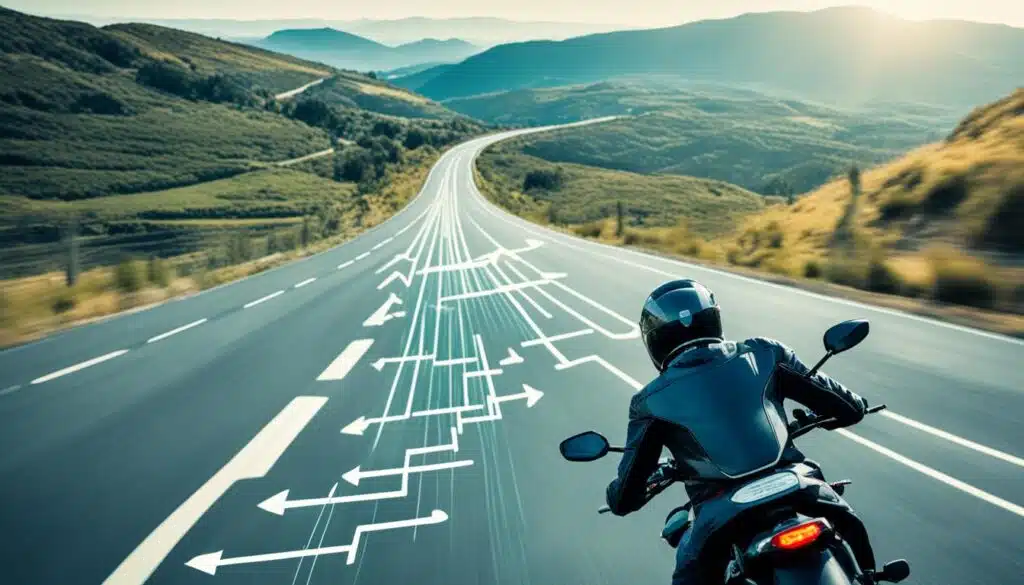
When it comes to motorbike finance, hire purchase (HP) is a popular option that allows you to acquire a bike directly from the dealer’s finance company. With HP, you pay a deposit upfront and then repay the remaining balance, along with interest, over an agreed loan period.
One of the key features of hire purchase is that ownership of the bike is not transferred to you until the final payment has been made. Until then, the bike is technically owned by the finance company. This arrangement provides convenience and flexibility in one package, allowing you to enjoy your motorbike while paying it off over time.
However, it’s important to note that interest rates for hire purchase from the dealer’s finance company may be higher compared to bank loans. This is why it’s essential to carefully consider the terms and conditions before committing to an HP agreement. Shop around and compare different finance options to ensure you get the best deal.
When optings for hire purchase, you’ll need to pay a deposit upfront. The deposit amount varies depending on the bike and the finance company. It’s important to note that the larger the deposit, the lower your monthly repayments will be. Therefore, it’s worth considering putting down a larger deposit if you can afford it.
Once you’ve paid the deposit, you’ll need to repay the remaining balance, along with interest, over the agreed loan period. The loan period can range from a few months to several years, depending on your preferences and budget. Keep in mind that the longer the loan period, the lower your monthly repayments will be, but you’ll end up paying more interest over time.
It’s important to carefully consider the loan period and ensure that the monthly repayments fit within your budget. You don’t want to overextend yourself financially. Remember that defaulting on repayments can have a negative impact on your credit score and may result in the bike being repossessed by the finance company.
Once you’ve made all the repayments, including the final payment, ownership of the bike will be transferred to you. At this point, you fully own the bike and are free to do whatever you wish with it. It’s worth celebrating this milestone as you’ll have acquired the bike through your own efforts and financial commitment.
To summarize, hire purchase (HP) is a popular motorbike finance option that allows you to acquire a bike directly from the dealer’s finance company. It involves paying a deposit, repaying the remaining balance with interest over an agreed loan period, and finally owning the bike after the final payment. While HP offers convenience and flexibility, it’s important to consider interest rates and compare different finance options to find the best deal for your budget and requirements.
Also Read : Stock Market News Updates And Insights
Benefits of Hire Purchase (HP) for Motorbike Finance
Hire purchase (HP) offers several benefits for those looking to finance their motorbike:
- Convenience and flexibility in acquiring a bike directly from the dealer’s finance company.
- Lower monthly repayments compared to buying a bike outright with cash.
- Opportunity to own the bike after the final payment.
“Hire purchase allows you to enjoy your motorbike while paying for it over time, making it an accessible option for many riders.” – Richard Davidson, Finance Expert
When considering motorbike finance, hire purchase is a viable option worth exploring. It provides convenience, flexibility, and the opportunity to own your dream bike. Just remember to carefully review the terms and conditions, compare interest rates, and choose a repayment plan that fits your budget. With hire purchase, you can hit the road and experience the thrill of riding while paying for your bike in manageable installments.
| Hire Purchase (HP) | Benefits |
|---|---|
| Acquire a motorbike directly from the dealer’s finance company | Convenience and flexibility |
| Repay the remaining balance with interest over an agreed loan period | Lower monthly repayments compared to cash purchase |
| Ownership of the bike transferred after the final payment | Opportunity to own the bike |
Understanding Personal Contract Purchase (PCP) for Motorbike Finance
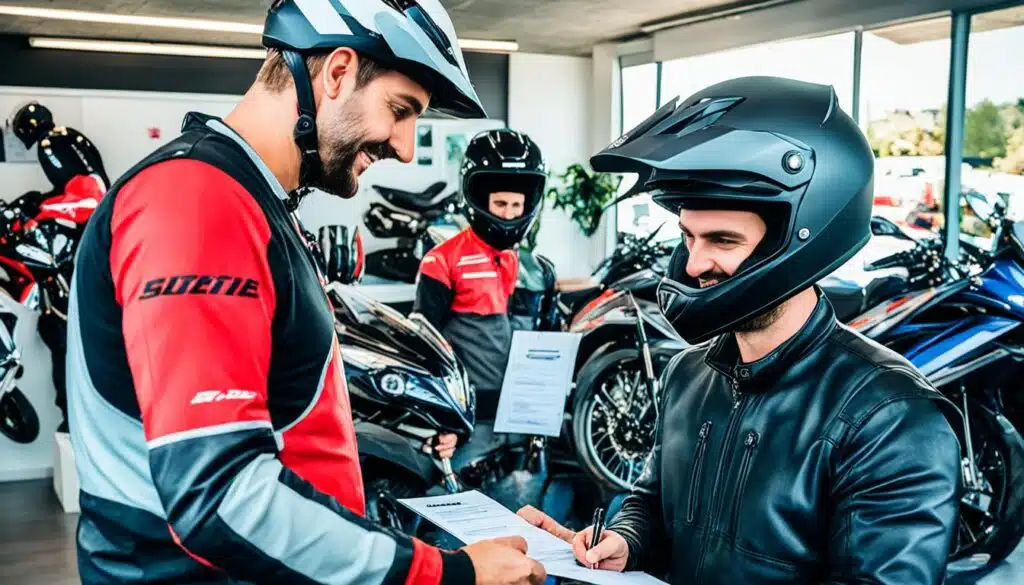
Personal Contract Purchase (PCP) is a popular option for financing new bikes. It offers lower monthly payments compared to other finance options. PCP works similarly to Hire Purchase (HP), but with a deferred payment structure that includes a balloon payment at the end of the agreement.
With PCP, you begin by paying a deposit, followed by fixed monthly instalments for a set period of time. The deposit can be as low as 10% of the bike’s value, allowing for more flexibility and affordability. The remaining balance, known as the balloon payment, is deferred until the end of the agreement.
At the end of the PCP agreement, you have three options:
- Pay the balloon payment and own the bike: If you choose to keep the motorbike, you can pay the agreed balloon payment, which is the remaining amount owed. Once the full payment is made, the bike becomes yours to keep.
- Hand the bike back: If you no longer want the motorbike, you can simply hand it back to the finance company. This option allows you to walk away without any further financial obligations.
- Use the bike as a deposit for a new PCP deal: If you wish to upgrade to a new motorbike, you can use the equity in the current bike as a deposit for a new PCP agreement. This option enables you to ride a brand-new bike with lower monthly payments.
It’s important to note that while PCP offers lower monthly payments, the balloon payment at the end of the agreement can be substantial. Be sure to consider your financial circumstances and the future value of the motorbike before committing to PCP.
PCP allows you to enjoy the benefits of riding a new motorbike while keeping monthly costs manageable. However, it’s important to remember that you don’t fully own the bike until the final payment is made. This means you’ll need to budget for the balloon payment or make a decision on whether to keep the bike, hand it back, or use it as a deposit for a new PCP deal.
Also Read : Navigating The Stock Market: Essential Tips
The Advantages of PCP:
“PCP enables you to ride a brand-new bike for lower monthly payments compared to other finance options.”
Considerations for PCP:
“Make sure to carefully consider the balloon payment and future value of the motorbike before entering into a PCP agreement.”
| Advantages of PCP | Considerations for PCP |
|---|---|
| Lower monthly payments | Substantial balloon payment |
| Flexibility to own, return, or upgrade | Consider future value of the motorbike |
| Access to brand-new motorbikes | Make sure it fits your budget |
Exploring Personal Contract Hire (PCH) for Motorbike Finance
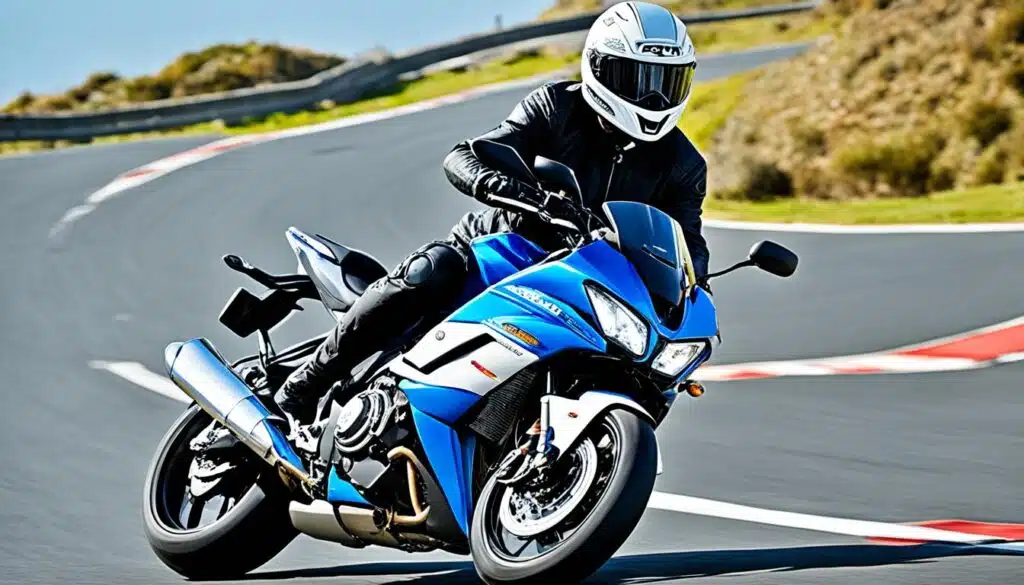
Personal Contract Hire (PCH) is a popular option for motorbike financing, offering flexibility and affordability without the commitment of ownership. With PCH, you can enjoy the benefits of riding a brand-new bike while avoiding the hassle of maintenance and the risk of depreciation. Let’s take a closer look at how PCH works and why it might be the right choice for you.
When you opt for PCH, you will need to pay a deposit upfront. This deposit is typically a percentage of the bike’s value. It serves as security for the finance provider and helps to reduce the monthly hire charges. The deposit amount will vary depending on the bike and the terms of the agreement.
Once you have paid the deposit, you will then pay monthly hire charges for the duration of the contract. These charges are predetermined and fixed, making budgeting easier. The monthly payments are typically lower compared to other finance options like hire purchase or personal contract purchase.
Benefits of Personal Contract Finance
There are several advantages to choosing PCH for motorbike finance:
- Affordable Monthly Payments: The fixed monthly hire charges in PCH plans are often lower compared to other forms of finance, making it easier to manage your budget.
- Access to Brand-New Models: With PCH, you can enjoy riding the latest models without the hassle of owning and selling a bike.
- No Depreciation Worries: As you don’t own the bike, you don’t have to worry about its depreciation or its impact on the bike’s future resale value.
- No Long-Term Commitment: PCH contracts typically last for a set period, allowing you to switch bikes every few years and keep up with the latest advancements in technology and design.
It’s important to note that with PCH, you don’t have the option to own the bike at the end of the contract. Instead, you will need to return the bike to the finance provider in good condition, adhering to any mileage limits and fair wear and tear guidelines specified in the agreement.
Personal Contract Hire (PCH) offers the benefits of affordable monthly payments, access to brand-new models, and freedom from depreciation worries. It’s a great option for those who prefer to switch bikes regularly without the commitment of ownership.
Is PCH Right for You?
PCH can be a suitable choice for riders who value flexibility, low monthly payments, and the joy of riding new models. It’s particularly popular for individuals, businesses, or contractors who like to keep up with the latest bike trends or who may have changing needs over time.
However, it’s important to consider your individual circumstances and preferences before committing to a PCH agreement. If you prefer to own the bike or if you ride high mileage, other finance options like hire purchase or personal contract purchase may be more appropriate.
Ultimately, the decision to choose PCH for motorbike finance is a personal one that should be based on your financial situation and goals as a rider.
| Pros | Cons |
|---|---|
| Lower monthly payments | No ownership at the end of the contract |
| Access to new models | Mileage restrictions may apply |
| No depreciation concerns | Fair wear and tear guidelines must be followed |
| Flexibility to switch bikes | Not suitable for high-mileage riders |
Consider the pros and cons of PCH in relation to your own needs and preferences to determine if it’s the right choice for you.
Also Read : Exploring The Benefits Of Embedded Finance
Factors to Consider When Choosing Motorbike Finance
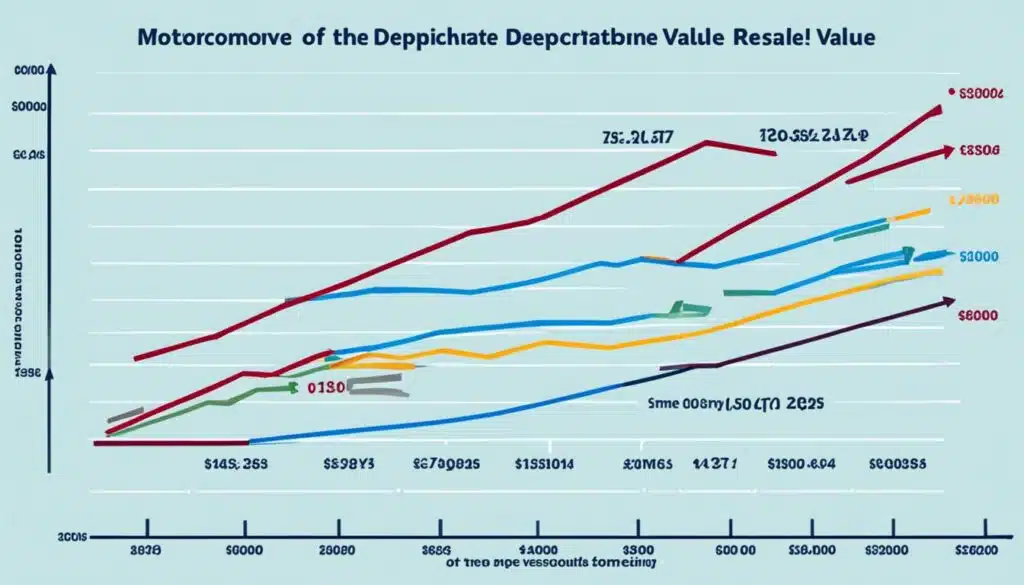
When deciding on motorbike finance, there are several important factors that you need to consider in order to make an informed decision. These factors will greatly impact your overall financial situation and ensure that you choose the option that best suits your needs.
Credit Rating
Your credit rating plays a vital role in securing motorbike finance. Lenders assess your creditworthiness based on your credit history and credit score. A good credit rating can help you secure better interest rates and more favorable finance terms. On the other hand, a poor credit rating may limit your options and result in higher interest rates.
Credit Agreement
It is crucial to carefully review and understand the terms and conditions of the credit agreement. This includes the interest rate, repayment period, and any fees or penalties associated with the finance. Ensuring that you have a clear understanding of the agreement will help you avoid any surprises or hidden costs down the line.
Mileage Limits
Some motorbike finance agreements may include mileage limits. These limits determine the maximum number of miles you can ride the bike without incurring additional costs. If you exceed the mileage limits, you may be subject to additional charges or higher interest rates. It’s important to evaluate your riding habits and choose a finance option that aligns with your expected mileage.
Maintenance Costs
When considering motorbike finance, don’t forget to account for maintenance costs. Regular servicing and maintenance are essential for keeping your bike in good condition and maintaining its value. It’s advisable to budget for these costs, including routine servicing, replacements, and repairs. This will help you avoid unexpected expenses and keep your bike running smoothly throughout the finance period.
Resale Value
It’s important to consider the expected resale value of the bike when evaluating different finance options. Some bikes have better resale value than others due to factors such as brand reputation, model popularity, and market demand. Understanding the potential resale value will give you an idea of the long-term financial implications of your motorbike finance decision.
Considering these factors will ensure that you make an informed decision when choosing motorbike finance. Your credit rating, understanding the credit agreement, mileage limits, maintenance costs, and resale value are all crucial elements to evaluate. By carefully considering these factors, you can select the finance option that best fits your needs and financial situation.
How to Apply for Motorbike Finance
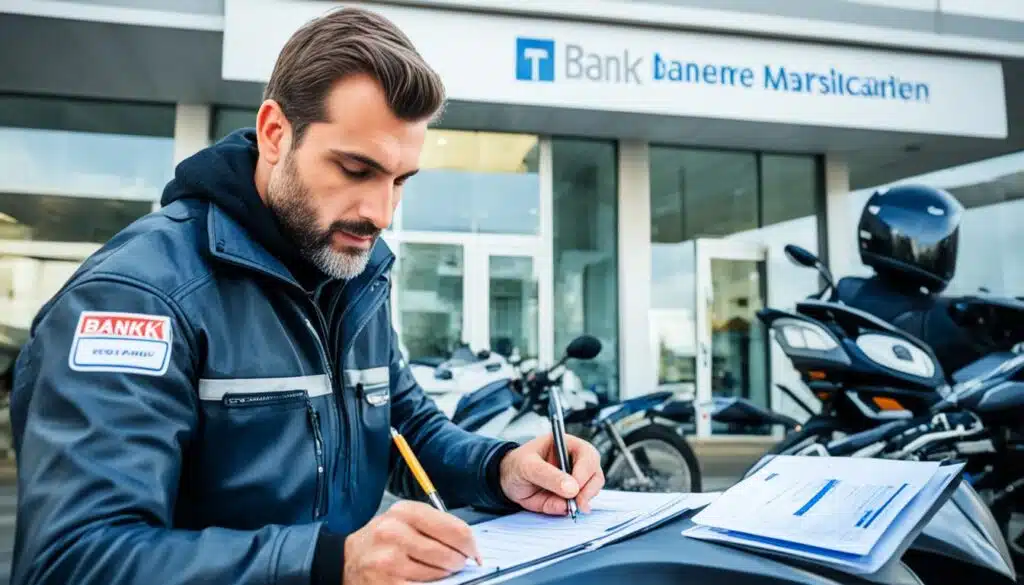
Applying for motorbike finance involves completing a finance application that will be assessed by a panel of lenders. It’s crucial to provide accurate information about your credit history and financial situation to increase your chances of approval. To simplify the process and find the most suitable finance options, you may consider working with a credit broker who has expertise and access to a wide range of lenders.
When completing the finance application, it’s important to provide all the necessary documentation, such as proof of income, bank statements, and identification documents. Lenders will review your creditworthiness based on your past financial behavior, including your credit history and payment patterns.
During the assessment, lenders will also evaluate your affordability to ensure that you can comfortably repay the loan. This assessment takes into account your monthly income, existing financial commitments, and living expenses. It’s essential to be honest about your financial situation to avoid taking on a loan that may become a burden in the future.
Once your finance application has been submitted, the lenders will review it and make a decision. If approved, you will receive the loan offer, detailing the terms and conditions of the finance agreement, including the loan amount, interest rate, repayment schedule, and any additional fees or charges. Review the offer carefully and seek clarification if you have any questions or concerns.
Before accepting the loan offer, take the time to compare it with other options available to you. Consider the interest rates, additional fees, repayment flexibility, and any specific terms that may impact your ability to use the bike as you intend. Choosing the right finance agreement is crucial to ensure that it aligns with your budget and long-term financial goals.
Once you have accepted the loan offer, the funds will be disbursed, and you can proceed with purchasing your motorbike. Make sure to adhere to the agreed repayment schedule and manage your finances responsibly to maintain a positive credit history.
Benefits of Applying for Motorbike Finance
There are several benefits to applying for motorbike finance, including:
- Flexibility: Motorbike finance offers various options that cater to different financial situations and preferences.
- Manage Cash Flow: By spreading the cost of the motorbike purchase, you can manage your cash flow and avoid a large upfront payment.
- Opportunity to Afford a Higher Specification Bike: With motorbike finance, you can access higher specification bikes that may have been out of your immediate budget.
- Build Credit History: Responsible repayment of the motorbike finance can help establish or improve your credit history, making it easier to access credit in the future.
Applying for motorbike finance provides a convenient and accessible way to purchase your dream bike. By following the application process and ensuring your creditworthiness and affordability, you can increase your chances of securing the finance you need.
| Step | Description |
|---|---|
| Step 1 | Complete the finance application form with accurate information about your credit history and financial situation. |
| Step 2 | Submit the completed application to the panel of lenders for assessment. |
| Step 3 | Consider working with a credit broker to find suitable finance options. |
| Step 4 | Provide any necessary documentation, such as proof of income and identification documents, as requested by the lenders. |
| Step 5 | Wait for the lenders to review your application and make a decision. |
| Step 6 | If approved, review the loan offer and compare it with other options before accepting. |
| Step 7 | Once accepted, the funds will be disbursed, and you can proceed with purchasing your motorbike. |
Applying for motorbike finance is a straightforward process that can open doors to owning your desired motorbike. With careful consideration of your financial situation and the options available to you, you can find a finance agreement that suits your needs and enables you to hit the road on your dream bike.
Motorbike Finance Examples and Comparison
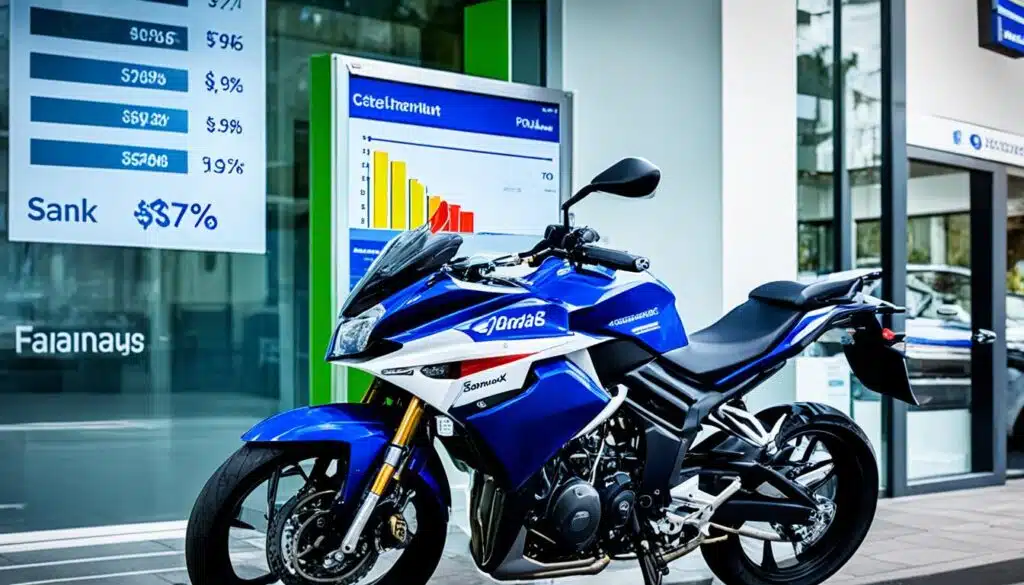
To illustrate how motorbike finance works in practice, let’s look at a couple of examples. Triumph’s Speed 400 offers manufacturer-backed finance deals for both Hire Purchase (HP) and Personal Contract Purchase (PCP). Here’s a comparison:
Finance Deal Comparison: Triumph’s Speed 400
| Finance Option | On-the-Road Price | Deposit | Monthly Payments | Final Balloon Payment | APR |
|---|---|---|---|---|---|
| HP | £4995 | Variable | Variable | N/A | Variable |
| PCP | £4995 | £999 | £67.84 for 36 months | £2512 | 9.9% |
The Triumph Speed 400 has an on-the-road price of £4995. With HP, the deposit and monthly payments will vary based on the terms of the agreement. However, no final balloon payment is required, and the APR will vary depending on the specific finance offer.
On the other hand, the PCP plan for the Speed 400 requires a £999 deposit and monthly payments of £67.84 for 36 months. At the end of the agreement, there is a final balloon payment of £2512. The APR for this PCP agreement is 9.9%.
Comparing different manufacturer-backed finance offers, such as HP and PCP, can help you find the best deal for your budget. Remember to consider factors like the deposit amount, monthly payments, final balloon payment, and APR when making your decision.
Motorbike Finance Glossary
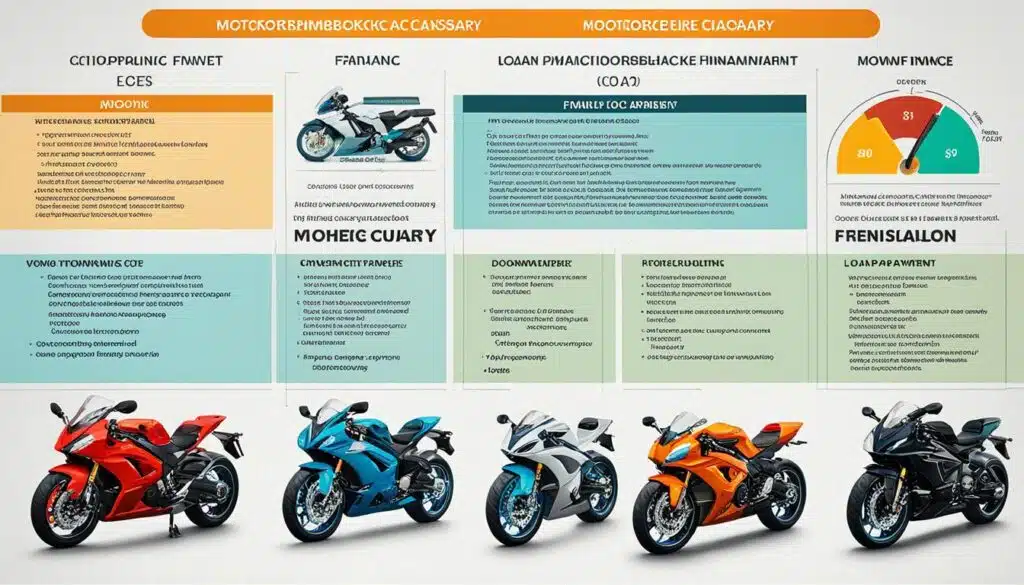
When exploring motorbike finance options, it’s important to have a clear understanding of key terms and concepts. Here is a glossary of terms related to motorbike finance:
Hire Purchase
Hire Purchase (HP) is a type of motorbike finance where you pay a deposit and make fixed monthly repayments over an agreed loan period. The bike is owned by the finance company until the final payment is made.
Personal Contract Purchase
Personal Contract Purchase (PCP) is a financing option that allows you to make lower monthly payments by deferring a portion of the loan amount to the end of the agreement. At the end, you can choose to pay the balloon payment and own the bike, hand it back, or use it as a deposit for a new deal.
Depreciation
Depreciation refers to the decrease in value of a motorbike over time. It is an important consideration when financing a bike, as it affects the bike’s resale value and equity.
Equity
Equity is the difference between the current market value of a bike and the amount owed on the finance agreement. Positive equity means the bike is worth more than the outstanding balance, while negative equity means the bike is worth less.
APR
APR stands for Annual Percentage Rate and represents the annual cost of borrowing, including interest and fees. It allows for easy comparison of different finance deals.
Balloon Payment
A balloon payment is a large final payment due at the end of a finance agreement, typically associated with PCP. It must be paid in order to own the bike outright.
Credit Agreement
A credit agreement is a legally binding contract between you and the finance provider, outlining the terms and conditions of the loan.
Credit History
Credit history refers to your past borrowing and repayment behavior. Lenders assess credit history to determine your creditworthiness and the interest rates you are offered.
Flat Rate
The flat rate is the annual interest rate calculated on the original loan amount. It does not take into account any reduced outstanding balance over time.
Residual Value
Residual value is the estimated value of the bike at the end of a finance agreement. It affects the balloon payment for PCP and the equity in the bike.
| Term | Definition |
|---|---|
| Hire Purchase | A type of motorbike finance where you pay a deposit and make fixed monthly repayments over an agreed loan period. The bike is owned by the finance company until the final payment is made. |
| Personal Contract Purchase | A financing option that allows you to make lower monthly payments by deferring a portion of the loan amount to the end of the agreement. At the end, you can choose to pay the balloon payment and own the bike, hand it back, or use it as a deposit for a new deal. |
| Depreciation | The decrease in value of a motorbike over time. |
| Equity | The difference between the current market value of a bike and the amount owed on the finance agreement. |
| APR | Annual Percentage Rate represents the annual cost of borrowing, including interest and fees. |
| Balloon Payment | A large final payment due at the end of a finance agreement, typically associated with PCP. |
| Credit Agreement | A legally binding contract between you and the finance provider, outlining the terms and conditions of the loan. |
| Credit History | Your past borrowing and repayment behavior. |
| Flat Rate | The annual interest rate calculated on the original loan amount. |
| Residual Value | The estimated value of the bike at the end of a finance agreement. |
Having a clear understanding of these terms will empower you to make informed decisions when exploring motorbike finance options.
Also Read: Exploring The Benefits Of Embedded Finance
Conclusion
Motorbike finance offers flexible options for financing a motorbike without requiring a large upfront payment. Whether you prefer to pay with cash, explore credit options, choose hire purchase, or opt for a personal contract purchase, understanding the different finance options and their implications is crucial. By carefully considering factors such as interest rates, ownership, monthly payments, and end-of-agreement choices, you can find the best motorbike finance deals that suit your budget and requirements.
Financing a motorbike allows you to spread the cost over time, making it more affordable and accessible. With a range of finance options available, such as credit cards, bank loans, and dealer finance packages, you can choose the method that works best for you. It is important to calculatethe total cost of finance, including fees and interest, to ensure that it fits within your budget comfortably.
When deciding on motorbike finance, take into account important factors such as your credit rating, mileage limits, maintenance costs, and the expected resale value of the bike. By understanding these considerations and making an informed decision, you can embark on your motorcycle journey with confidence, knowing that you have secured the best motorbike finance option available.
FAQs
Q: How does motorbike finance work?
A: Motorbike finance works by allowing you to spread the cost of purchasing a motorbike over a period of time through monthly repayments. You can choose from different types of finance options such as hire purchase or personal contract purchase.
Q: Can I get motorbike finance with bad credit?
A: Yes, there are options available for getting motorbike finance with bad credit. Some lenders specialize in bad credit motorbike finance and may offer higher interest rates or require a larger deposit.
Q: What is a deposit in motorbike finance?
A: A deposit in motorbike finance is an initial amount of money that you pay towards the purchase of the motorbike. The size of the deposit can affect your monthly repayments and the total cost of the finance.
Q: How can I calculate my motorbike finance repayments?
A: You can use a finance calculator to estimate your monthly repayments based on factors like the loan amount, interest rate, and term of the finance agreement.
Q: Are there guaranteed motorbike finance options available?
A: While there are no guaranteed motorbike finance options, there are lenders who may be more willing to work with individuals with bad credit or other financial circumstances.
Q: Can I get a 125cc motorbike on finance?
A: Yes, many lenders offer financing for 125cc motorbikes. You can explore different finance options to find the best deal for your budget and needs.
Q: Will applying for motorbike finance impact my credit score?
A: When you apply for motorbike finance, the lender may run a credit check which can temporarily impact your credit score. However, multiple credit checks within a short period of time can have a negative effect on your score.









